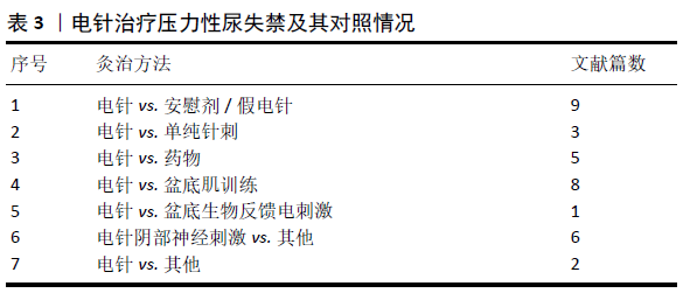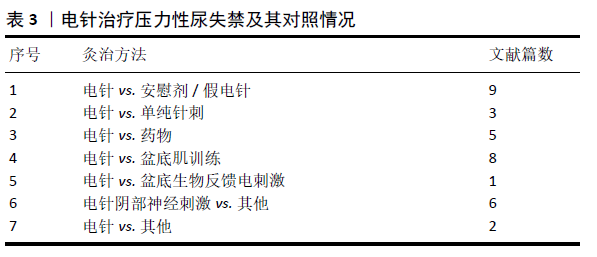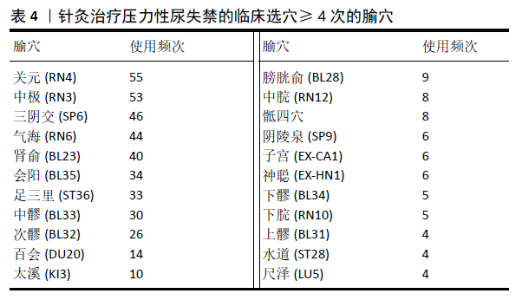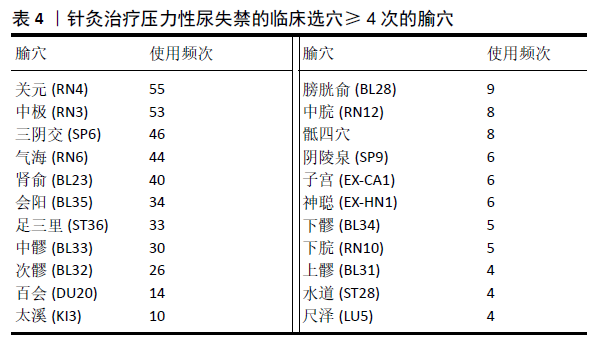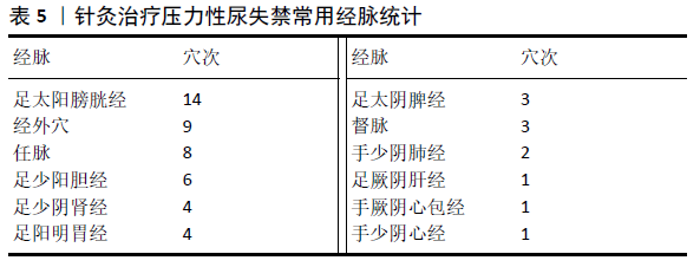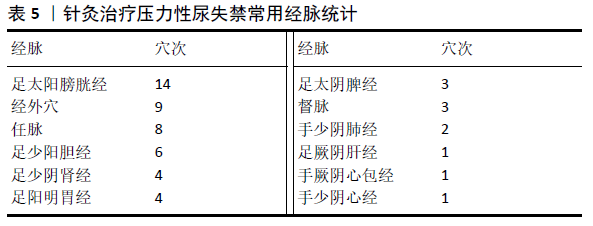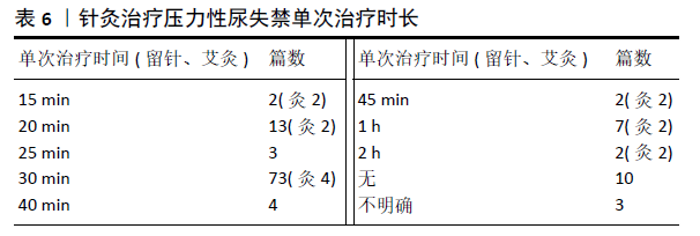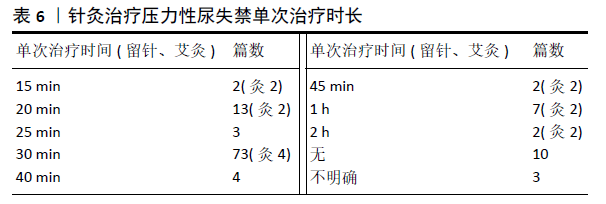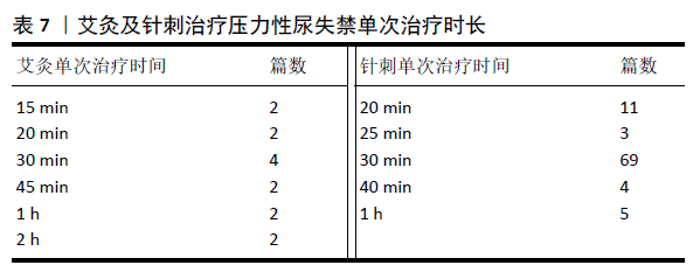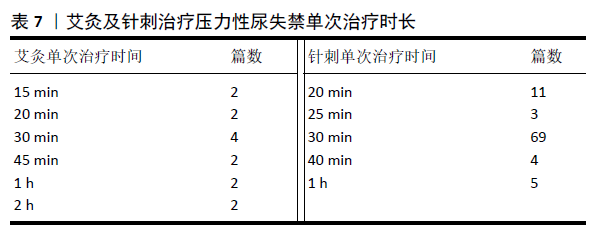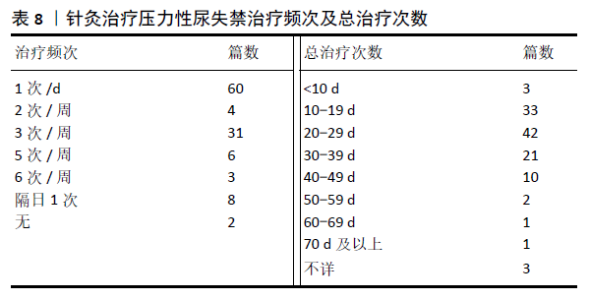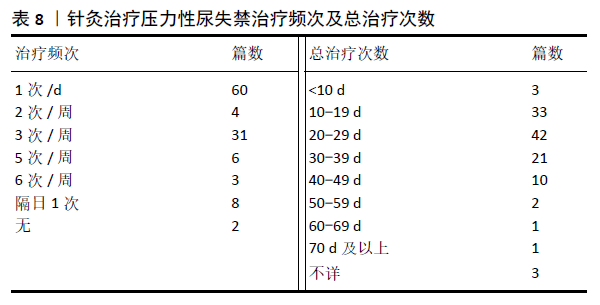Chinese Journal of Tissue Engineering Research ›› 2021, Vol. 25 ›› Issue (32): 5197-5203.doi: 10.12307/2021.224
Previous Articles Next Articles
Characteristics of randomized controlled trials on acupuncture for stress urinary incontinence in women
Bai Fuyu1, Wang Mengqi2, Xue Feng3, Li Zhenrui1, Yan Qinghao1, Zhang Zhiyi1, Wang Feng1, 4
- 1Shanghai University of Traditional Chinese Medicine, Shanghai 200120, China; 2School of Medicine, Shanghai Jiao Tong University, Shanghai 200025, China; 3Central Hospital of Fengxian District, Shanghai 201499, China; 4Xiangshan Hospital of Traditional Chinese Medicine, Shanghai 200020, China
-
Received:2020-07-20Revised:2020-07-22Accepted:2020-09-15Online:2021-11-18Published:2021-07-26 -
Contact:Wang Feng, Associate chief physician, Master’s supervisor, Shanghai University of Traditional Chinese Medicine, Shanghai 200120, China; Xiangshan Hospital of Traditional Chinese Medicine, Shanghai 200020, China -
About author:Bai Fuyu, Master candidate, Shanghai University of Traditional Chinese Medicine, Shanghai 200120, China -
Supported by:The Chinese Medicine Foundation of Shanghai Municipal Health Commission, No. 2014LP041A (to WF); Science and Technology Project of Shanghai Huangpu District, No. HKW201405 (to WF); The Project of Improving Diagnosis and Treatment using Traditional Chinese Medicine, Shanghai Municipal Health and Family Planning Commission, No. Zyix-2017033 (to WF); Scientific Research Project of Shanghai Huangpu District Health Commission, No. ZY-2019RCTDPY-1004 (to WF)
CLC Number:
Cite this article
Bai Fuyu, Wang Mengqi, Xue Feng, Li Zhenrui, Yan Qinghao, Zhang Zhiyi, Wang Feng. Characteristics of randomized controlled trials on acupuncture for stress urinary incontinence in women[J]. Chinese Journal of Tissue Engineering Research, 2021, 25(32): 5197-5203.
share this article
Add to citation manager EndNote|Reference Manager|ProCite|BibTeX|RefWorks
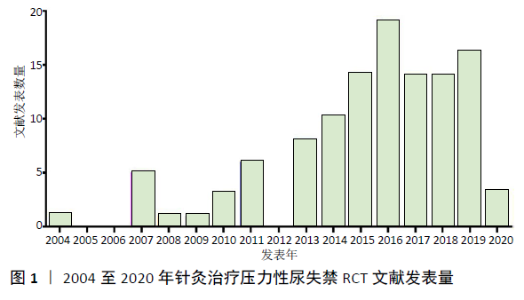
2.1 文献检索结果 根据检索策略,共检索到中英文文献共 1 510篇,中文1 353篇文献,英文157篇,其中CNKI为356篇,Wangfang为503篇,VIP为261篇,SinoMed为233篇,Pubmed为17篇,Embase 为76篇,Cochrane Library为48篇,Clinical Evidence为16篇。根据纳入标准和排除标准,最终共纳入115篇文献,包含中文110篇,英文5篇。文献类型包括期刊文献、会议论文及研究生学位论文。 针灸治疗女性压力性尿失禁的临床RCT文献年发表量2011年前不稳定,2012年由0篇逐步增长达到19篇(2016年),近几年趋于稳定分别为14篇(2017年)、14篇(2018年)、16篇(2019年),见图1。 "
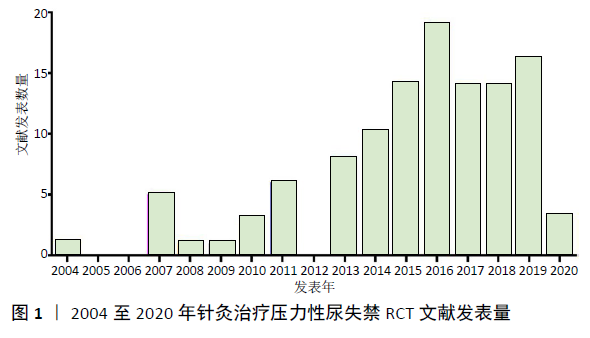
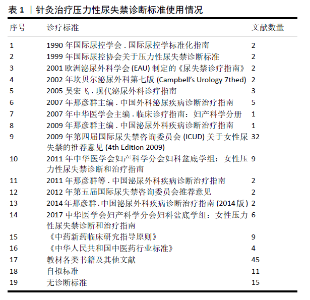
2.2 诊断标准评估 对纳入的115篇文献的诊断标准进行汇总统计,结果显示:15篇未说明采用了何种诊断标准,100篇文献有诊断标准。使用频率最高的两个诊断标准分别是“2009年第四届国际尿失禁咨询委员会(ICUD)关于女性尿失禁的推荐意见(4th Edition 2009)”(32次)[8]和“2011年中华医学会妇产科学分会妇科盆底学组:女性压力性尿失禁诊断和治疗指南”(9次)[9]。有19篇文献同时采用了西医和中医两套诊断标准,中医诊断标准除了诊断疾病外,更侧重辨证分型,以学位论文居多。 第四届国际尿失禁推荐意见(4th Edition 2009)内容全面详实,有1 800余页,这是其引用率远超过其他文献的主要原因之一,且近年来仍被较多文献引用[10-12]。与之相比,第六届国际尿失禁推荐意见(6th Edition 2017)篇幅较少,只是在其基础上进行更新优化,更新了部分最新的临床证据,故近年来未见引用。详见表1。 "
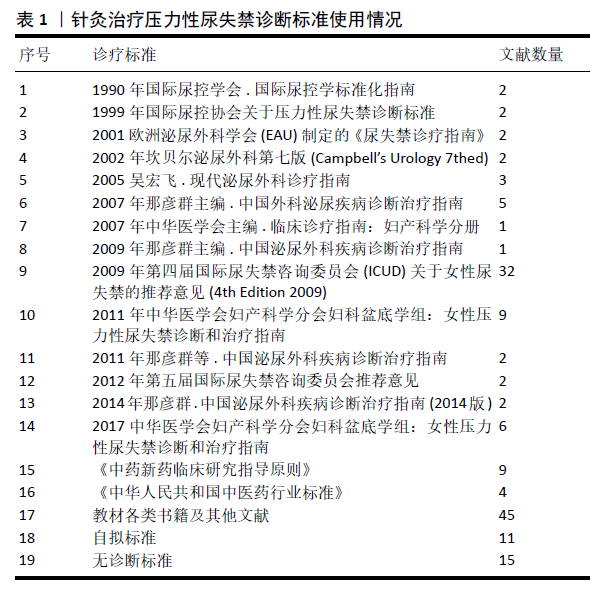
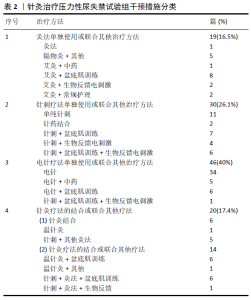
2.3 针灸疗法的使用 对纳入115篇文献的试验组干预措施进行统计,结果表明有针刺疗法单独使用或联合其他疗法、灸法单独使用或其联合其他疗法、针灸结合或联合其他疗法三类。最常见的联合疗法为针灸联合盆底肌训练、生物反馈、还有电刺激、药物以及常规护理等。在药物疗法中,单独成组的对照组多为西药,有盐酸米多君(管通)、盐酸度洛西汀、雌激素[13-16];中药多用于联合成组,均为硕士学位论文[17-18]。 常用的针灸疗法包括单纯针刺、电针、灸法、温针灸等,其中电针单独使用的频率最高(34篇),文献质量也相对较高,值得关注。此次研究所纳入5篇英文文献均为电针治疗,其中3篇为电针vs.假电针[5,19-20],其中假电针组中穴位在中髎、会阳外1寸,非穿透皮肤,不通电;亦有浅刺中髎、会阳。1篇为电针vs.盆底肌训练[21];1篇为电针阴部神经vs.生物反馈辅助盆底肌训练和经阴道电刺激[6]。此外,纳入文献中艾灸方法多样,有艾条、艾炷、温针灸、间接灸以及铺灸、热敏灸等。详情见表2和表3。 "
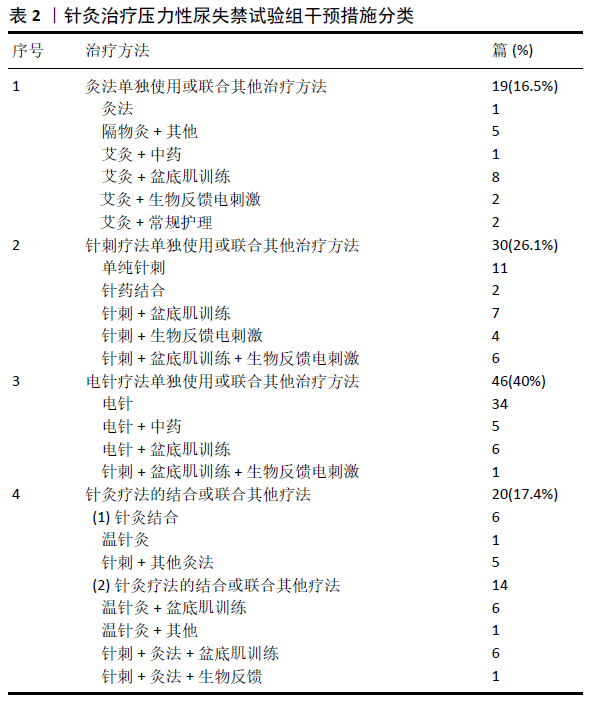
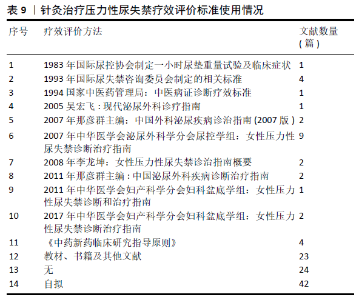
2.6 疗效标准 对115篇纳入文献的疗效标准进行了统计,疗效标准的使用情况多以自行拟定为主(45篇),不够统一和规范。引用最多为行业标准“2007年中华医学会泌尿外科学分会尿控学组:女性压力性尿失禁诊断治疗指南”(9篇)。该指南是中国第一版压力性尿失禁诊断治疗指南,介绍了国外诊治进展、建立指南的目的意义与程序方法,与2017版指南相比多病因病机,并在附录中全面介绍了常用的检查方法和排尿日记以及多种量表问卷,所以有9篇引用该版本。而2017版根据最新临床证据更新了程度诊断(由1 g以内轻度改为2-5 g)和盆底肌训练时间(2个月改为3个月),并删除了一些药物治疗和合并症的处理、预防,简化了随访,相对变动不算很大,但更细化贴近临床,故亦有2篇文献引用。详情见表9。 "
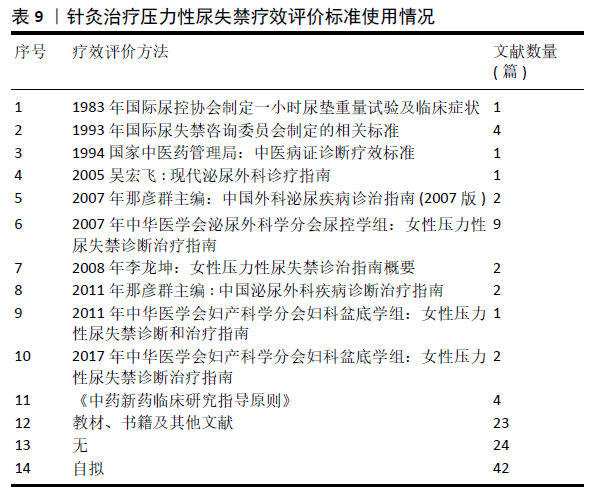
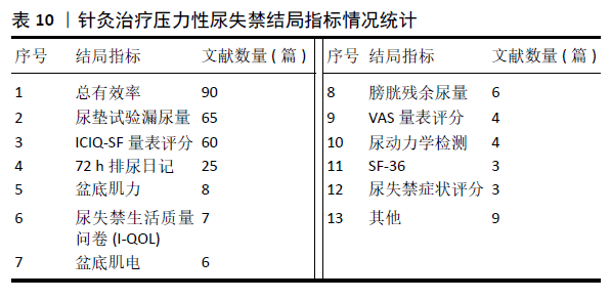
2.7 结局指标 对115篇纳入文献结局指标进行了统计,主要以总有效率、尿垫试验漏尿量、ICIQ-SF量表评分、72 h排尿日记四者居多。部分文献采用多个结局指标对压力性尿失禁疗效进行多方面评估,详情如下:①总有效率,并没有固定的格式,大多分为3级(痊愈、有效、无效)和4级(痊愈、优效、微效、无效),缺少固定标准与分级。在3级中,有文献引用国内指南推荐的手术疗效的评价内容,即1 h尿垫试验漏尿量较治疗前减少≥50%才为有效,结局较有说服力[23-24]。此外有文献以1 h尿垫试验为有效率的评价依据[24-27],也有文献参照ICIQ-SF量表评分来制定有效率[28-29],或有文献同时参照1 h尿垫试验和ICIQ-SF量表评分[30];有文献以患者尿失禁的次数及量以及生活影响程度来定制有效率[31];还有文献参照国家标准《中医病证诊断疗效标准》[32-33]。②尿垫试验作为客观指标被国内外推荐,尤其1 h尿垫试验漏尿量。在65篇尿垫试验中,其使用率达89.2%(58/65)。③排尿日记和ICIQ-SF量表评分被国内2007,2017版指南推荐。排尿日记:尿漏患者强烈建议使用来记录排尿频率、排尿量、尿失禁发作和尿失禁垫的使用情况,第六届国际尿失禁推荐意见(6th Edition 2017)中推荐至少3 d(3级-C级),可较为准确评估压力性尿失禁患者尿失禁症状和严重程度。有25篇文献引用72 h排尿日记,平均24 h有6篇;尿动力学检测在第四届国际尿失禁推荐意见(4th Edition 2009)中多用于手术检测,非必须。详情见表10。 "
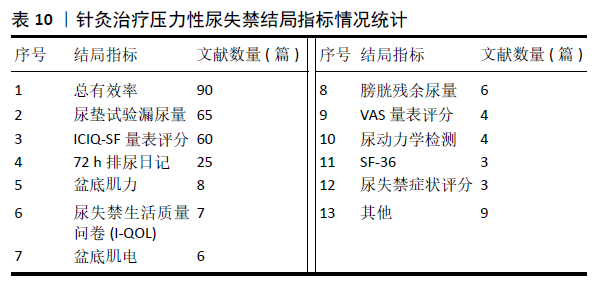
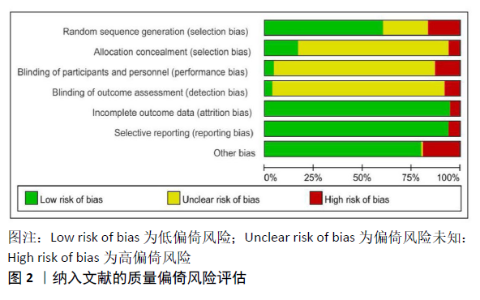
2.8 临床针刺操作方法特点 2.8.1 得气 在115篇纳入文献中,47篇仅提及“得气”或是描述了酸麻胀痛等得气感;33篇描述了针刺八髎穴(次髎、中髎居多)、会阳、“骶四穴”、气海、关元、中极可产生阴部传导放射和(或)伴有小腹部传导,电针可伴有局部肌肉收缩。 2.8.2 针刺手法 多数文献未阐述针刺手法,仅有19篇文献提到平补平泻,20篇文献运用了补法,其中运用了捻转补法有12篇,描述提插补法和提插捻转补法各有2篇。 2.8.3 针刺角度及针刺深度 腹部及下肢穴位一般直刺 25-30 mm(1-1.2寸),但腹部斜刺时(如关元穴)可进针 40-50 mm (1.5-2寸),针感可持续传至膀胱、会阴及尿道。骶部穴位常用芒针,八髎穴斜刺进针50-60 mm,亦有文献报道可刺入70-80 mm,针感可持续传至会阴及尿道。骶四穴中上两针刺点针刺深度为75-90 mm(3-3.5寸),下两针刺点针刺深度为90-110 mm(3.5-4.5寸),均需使针感达阴部(尿道或肛门)。以上穴位均可根据患者体质胖瘦适当增加或减少进针深度。另外,头针(如百会)可斜刺或平刺 15-20 mm(0.5-0.8寸),刺入帽状腱膜,快速捻转以患者局部有沉重胀感为度,有文献报道行针时可让患者做膀胱约束动作[33-34],属于动针疗法。百会、四神聪多属于大脑皮层排尿高级中枢控制区,对治疗尿失禁有显著作用。 2.8.4 电针参数 在运用电针治疗压力性尿失禁的过程中,电针参数的选择非常重要。连续波27篇,疏密波14篇,疏波9篇,断续波1篇;频率不规范见有1,2,2.5,3,4,5,10,15,20,50 Hz不等,最大可见70 Hz;电流强度一般均为1-5 mA;亦有部分文献见0.1-1 mA。最常见电针参数为连续波,频率 50 Hz,电流强度 1-5 mA,逐渐增大电流强度以患者耐受为度(12篇)。由于电针参数多、变化大,中国国家电针操作标准无明确规定参数,只根据疾病的性质出具了参考意见[35]。 2.9 临床研究方法设计 2.9.1 研究规模及分组 在纳入的115篇文献中,总共涉及2 294例压力性尿失禁患者,均为女性,试验平均样本量为134.9例,最小38例,最大504例。分组中,分为2组(试验组和对照组)104篇、3组10篇、4组1篇。 2.9.2 研究对象 产后压力性尿失禁有13篇、围绝经期压力性尿失禁有3篇和老年压力性尿失禁有5篇。产后是因为妊娠时对盆底肌肉进行压迫和牵拉以及分娩时更加大对盆底组织肌肉的牵拉甚至损伤。围绝经期主要是妇女内分泌代谢紊乱和身体素质的突然改变,尤其是雌激素的不足会导致盆底组织肌肉得不到雌激素的营养出现萎缩、松弛。老年为身体素质整体下降。 2.9.3 文献质量评估 采用Cochrane偏倚风险评估工具对115篇纳入文献的质量进行评估[36-37],结果显示:选择偏倚中,88篇报告了随机序列的产生,有69篇为低风险偏倚;36篇进行了分配隐藏,19篇为低风险偏倚。19篇进行了实施偏倚,其中5篇(均英文)为低风险偏倚。12篇文献报告了测量偏倚,其中4篇(均英文)为低风险偏倚。有109篇为低风险偏倚的随访偏倚;108篇为低风险报告偏倚。22篇(3篇英文)报道了脱落或是退出;20篇对患者进行了远期随访。详情见图2。 "
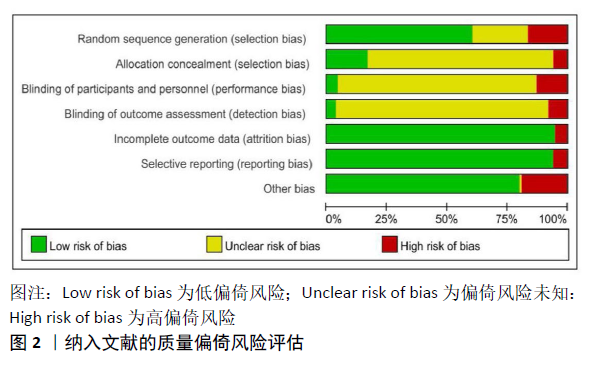
| [1] REYNOLDS WS, DMOCHOWSKI RR, PENSON DF. Epidemiology of stress urinary incontinence in women. Curr Urol Rep. 2011;12(5):370-376. [2] 李志毅,朱兰.女性压力性尿失禁流行病学现状[J].实用妇产科杂志, 2018,34(3):161-162. [3] COYNE KS, KVASZ M, IRELAND AM, et al. Urinary incontinence and its relationship to mental health and health-related quality of life in men and women in Sweden, the United Kingdom,and the United States. Eur Urol. 2012;61:88-95. [4] 中华医学会妇产科学分会妇科盆底学组.女性压力性尿失禁诊断和治疗指南(2017)[J].中华妇产科杂志,2017,52(5):289-293 [5] LIU Z, LIU Y, XU H, et al. Effect of Electroacupuncture on Urinary Leakage Among Women With Stress Urinary Incontinence:A Randomized Clinical Trial. JAMA. 2017;317(24):2493-2501. [6] WANG S, LV J, FENG X, et al. Efficacy of electrical pudendal nerve stimulation in treating female stress incontinence. Urology. 2016;91:64-69. [7] WANG S, ZHANG S. Simultaneous perineal ultrasound and vaginal pressure measurement prove the action of electrical pudendal nerve stimulation in treating female stress incontinence. BJU Int. 2012;110(9):1338-1343. [8] ABRAMS P, ANDERSSON K E, BIRDER L, et al. Fourth International Consultation on Incontinence Recommendations of the International Scientific Committee:Evaluation and treatment of urinary incontinence,pelvic organ prolapse,and fecal incontinence. Neurourol.Urodyn. 2010;29:213-240. [9] 中华医学会妇产科学分会妇科盆底学组.女性压力性尿失禁诊断和治疗指南(试行)[J].中华妇产科杂志,2011,46(10):796-798. [10] 乔雪奇,安军明.热敏灸联合盆底肌锻炼治疗女性压力性尿失禁[J].河南中医,2019,39(10):1575-1578. [11] 陈艳明,董玉喜,易姣姣.温针灸治疗女性压力性尿失禁30例临床观察[J].湖南中医杂志,2019,35(6):69-70. [12] 王子臣,杨晓锋,左晓玲,等.沈氏芒针治疗女性压力性尿失禁的临床研究[J].河北中医药学报,2019,34(1):34-36. [13] 毕伟莲.电针治疗女性压力性尿失禁[J].中华中医药学刊,2007,25(6): 1284-1285. [14] 肖春风,李建坤,韦哲,等.艾灸关元穴治疗老年女性压力性尿失禁30例[J].国际中医中药杂志,2013,35(5):442. [15] 刘样,胡蓉,袁光辉,等.艾灸配合盆底肌训练治疗产后压力性尿失禁临床观察[J].上海针灸杂志,2018,37(2):192-195. [16] 王伟,姜义明,王蓉,等.电针治疗轻中度女性压力性尿失禁疗效观察[J].上海针灸杂志,2016,35(1):47-49. [17] 李爽.针药结合治疗肾阳虚型围绝经期压力性尿失禁的临床疗效观察[D].哈尔滨:黑龙江中医药大学,2018. [18] 戚莹莹.电针结合中药治疗女性单纯压力性尿失禁的临床疗效观察[D].哈尔滨:黑龙江中医药大学,2017. [19] LIU Z, XU H, CHEN Y, et al. The efficacy and safety of electroacupuncture for women with pure stress urinary incontinence: study protocol for a multicenter randomized controlled trial. Trials. 2013;14:315. [20] XU H, LIU B, WU J, et al.A Pilot randomized placebo controlled trial of electroacupuncture for women with pure stress urinary incontinence. PLoS One. 2016;11(3):e0150821. [21] SU T, ZHOU J, LIU Z, et al. The efficacy of electroacupuncture for the treatment of simple female stress urinary incontinence-comparison with pelvic floor muscle training: study protocol for a multicenter randomized controlled trial.Trials. 2015;16:45. [22] 王静.针刺后予雷火灸手法操作配合盆底肌群锻炼治疗压力性尿失禁效果观察[J].中医临床研究,2015,7(36):119-120. [23] 胡丹,邓鹏,焦琳,等.热敏灸加腹针疗法联合盆底肌训练法治疗女性压力性尿失禁28例临床观察[J].中医杂志,2017,58(19):1662-1665. [24] 胡丹,邓鹏,焦琳,等.热敏灸联合Kegel锻炼疗法治疗女性压力性尿失禁疗效观察[J].针刺研究,2017,42(4):338-341. [25] 陈申旭,张馥晴,汪司右.电针阴部神经刺激疗法治疗女性压力性尿失禁临床研究[J].针灸临床杂志,2014,30(3):5-8. [26] 河恩惠,陈胤希,田鸿芳,等.电针治疗女性压力性尿失禁不同针刺疗程的疗效观察[J].中国针灸,2016,36(4):351-354. [27] 王琳琳,任志欣,朱敬云,等.电针联合透灸治疗产后压力性尿失禁疗效观察[J].中国针灸,2019,39(6):599-603. [28] 郑慧敏,徐世芬,尹平,等.电针治疗轻中度女性压力性尿失禁的近远期疗效观察[J].世界中西医结合杂志,2015,10(2):191-193+209. [29] 王伟,姜义明,王蓉,等.电针治疗轻中度女性压力性尿失禁疗效观察[J].上海针灸杂志,2016,35(1):47-49. [30] 赵洁晶,崔秀敏,卢耀能,等.针刺联合隔附子饼灸治疗老年女性压力性尿失禁临床研究[J].世界中医药,2016,11(5):891-893. [31] 张春敏.盆底康复训练联合针灸对产妇产后压力性尿失禁及盆底肌力的影响[J].中国妇幼保健,2018,33(9):1975-1978. [32] 陈卓伟,王敦建,袁瑷芹.针刺夹脊穴配合盆底肌功能锻炼治疗产后压力性尿失禁疗效观察[J].上海针灸杂志,2017,36(3):308-311. [33] 陈元霄,马睿杰.电针会阳、中髎穴结合头针治疗女性压力性尿失禁临床观察[J].上海针灸杂志,2015,34(12):1159-1161. [34] 费凌志,王晓颖,张海峰.头针结合骶四针治疗女性压力性尿失禁临床研究[J].新中医,2020,52(1):142-145. [35] 王频,杨华元,胡银娥.国家标准《针灸技术操作规范第11部分:电针》研制体会[J].中国针灸,2010,30(5):413-419. [36] 郭盛楠,齐淑兰,杨立丽,等.中医药研究人员对随机对照试验质量评价工具/报告规范认识现状的横断面调查[J].中华中医药杂志,2018, 33(3):1077-1081. [37] 谷鸿秋,王杨,李卫.Cochrane偏倚风险评估工具在随机对照研究Meta分析中的应用[J].中国循环杂志,2014,29(2):147-148. [38] 莫倩,刘志顺.针灸治疗压力性尿失禁的诊疗特点分析[J].上海针灸杂志,2013,32(12):1060-1063. [39] 王孟琦,王峰.近20年来针灸治疗压力性尿失禁的临床研究进展[J].中医药学报,2019,47(6):73-78. [40] 陈妮妮,赵培培,杜莉,等.针灸治疗压力性尿失禁的随机对照试验文献计量研究[J].上海针灸杂志,2020,39(7):937-942. [41] 赵琳,汪司右.不同治疗频次对女性压力性尿失禁疗效的影响[J].中国针灸,2013,33(12):1088-1090. [42] DAVID MOHER,SALLY HOPEWELL,KENNETH F SCHULZ,等.CONSORT 2010说明与详述:报告平行对照随机临床试验指南的更新[J].中西医结合学报,2010,8(8):701-741. [43] HUGH MACPHERSON,DOUGLAS G.ALTMAN,RICHARD HAMMERSCHLAG,等.针刺临床试验干预措施报告标准修订版:CONSORT声明的扩展[J].中国循证医学杂志,2010,10(10):1228-1239. |
| [1] | Jiang Xiaocheng, Shi Lu, Wang Yinbin, Li Qiujiang, Xi Chuangzhen, Ma Zefeng, Cai Lijun. Systematical evaluation of bone fusion rate after interbody fusion in patients with osteoporosis and lumbar degenerative disease treated with teriparatide [J]. Chinese Journal of Tissue Engineering Research, 2023, 27(9): 1427-1433. |
| [2] | Li Wenjie, You Aijia, Zhou Junli, Fang Sujuan, Li Chun. Effects of different dressings in the treatment of burn wounds: a network meta-analysis [J]. Chinese Journal of Tissue Engineering Research, 2023, 27(7): 1141-1148. |
| [3] | Bai Siqi, Xiao Zhen, Liu Jing. Application potential of adipose-derived stem cells in female pelvic floor dysfunction diseases [J]. Chinese Journal of Tissue Engineering Research, 2023, 27(6): 921-927. |
| [4] | Yin Shuoxin, Zhang Tao, Wang Shuping, Lu Xin, Huang Xuping, Yin Mengying, Yang Yuwei, Yuan Bingmao, Mao Zhihua, Chen Yuanneng. Bibliometric and visualized analysis of researches on gastric cancer stem cells [J]. Chinese Journal of Tissue Engineering Research, 2023, 27(6): 941-947. |
| [5] | Wang Suping, Qiu Demei, Fan Zhonghe, Hu Bo. Bibliometrics and visual analysis of research in the field of rehabilitation for femoroacetabular impingement syndrome in the past decade [J]. Chinese Journal of Tissue Engineering Research, 2023, 27(17): 2754-2762. |
| [6] | Peng Tuanhui, Yang Ling, Ding Xiaoge, Meng Pengjun. A systematic review and meta-analysis of the effects of long-term exercise on blood lipids in healthy elderly people [J]. Chinese Journal of Tissue Engineering Research, 2023, 27(14): 2276-2282. |
| [7] | Jing Jinpeng, Zhang Yue, Liu Xiaomin, Liu Yi. Traditional Chinese medicine injection for promoting blood circulation in prevention of deep vein thrombosis after orthopedic surgery: network meta-analysis [J]. Chinese Journal of Tissue Engineering Research, 2022, 26(9): 1467-1476. |
| [8] | Liu Gang, Ma Chao, Wang Le, Zeng Jie, Jiao Yong, Zhao Yi, Ren Jingpei, Hu Chuanyu, Xu Lin, Mu Xiaohong. Ankle-foot orthoses improve motor function of children with cerebral palsy: a Meta-analysis based on 12 randomized controlled trials [J]. Chinese Journal of Tissue Engineering Research, 2022, 26(8): 1299-1304. |
| [9] | Wei Zhoudan, Li Wenjin, Zhu Li, Wang Yu, Zhao Jiaoyang, Chen Yanan, Guo Dong, Hao Min. Platelet-rich fibrin as a material for alveolar ridge preservation significantly reduces the resorption of alveolar bone height and width after tooth extraction: a meta-analysis [J]. Chinese Journal of Tissue Engineering Research, 2022, 26(4): 643-648. |
| [10] | Wang Tiegang, Pan Lina, Wang Hai, Yang Tiansong, Sun Zhongren. Therapeutic effect of Rod Tuina combined with electrical stimulation biofeedback on stress urinary incontinence in adult women: changes in surface electromyography values of pelvic floor muscles [J]. Chinese Journal of Tissue Engineering Research, 2022, 26(35): 5693-5699. |
| [11] | He Qize, Meng Lin, Wang Jie, Weng Chenyi. Citespace-based visual analysis of research literature related to cartilage repair using cartilage precursor cells [J]. Chinese Journal of Tissue Engineering Research, 2022, 26(29): 4723-4728. |
| [12] | Zhang Tiantian, Li Jiamin, Ou Liang, Shang Yan, Xu Yaqian, Hu Guoheng. Electromyographic biofeedback for post-stroke limb spasticity: a Meta-analysis [J]. Chinese Journal of Tissue Engineering Research, 2022, 26(29): 4742-4748. |
| [13] | Zhou Junli, Wang Xiaojun, Wang Haijiao, Li Chun. A network meta-analysis of the efficacy of new medical dressings for diabetic foot ulcers [J]. Chinese Journal of Tissue Engineering Research, 2022, 26(16): 2562-2569. |
| [14] | Xue Xiali, Deng Zhongyi, Sun Junzhi, Li Ning, Ren Wenbo, Zhou Ling, He Ye. Hot spots and frontiers of rehabilitation robot research in recent 10 years: a bibliometric analysis based on the Web of Science database [J]. Chinese Journal of Tissue Engineering Research, 2022, 26(14): 2214-2222. |
| [15] | Zhao Tianyu, Jin Song, Zhang Di, Liu Xiaoxiao, Ma Jiang, Wang Ju. Baduanjin training for patellar tendinopathy in a randomized controlled trial: improving pain, muscle flexibility and lower limb balance stability [J]. Chinese Journal of Tissue Engineering Research, 2022, 26(11): 1662-1668. |
| Viewed | ||||||
|
Full text |
|
|||||
|
Abstract |
|
|||||
